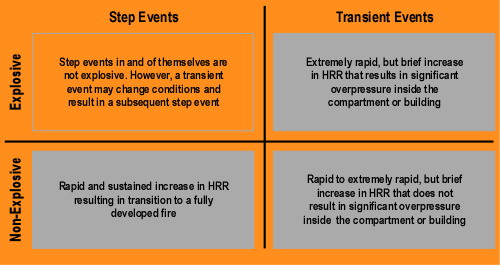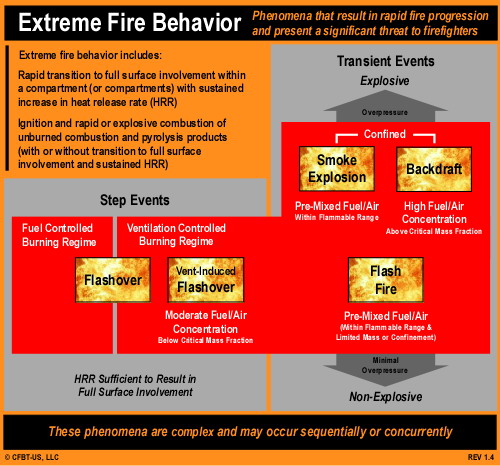In Fire Gas Ignitions and Language & Understanding: Extreme Fire Behavior, I pointed out the ambiguity in definition of terms related to extreme fire behavior. In the structural firefighting context, the term extreme fire behavior is used to identify phenomena that result in rapid fire progression and present a significant threat to firefighters. Rapid fire progression may involve transition to a fully developed fire (e.g., flashover) or it may involve a brief, but significant increase in energy release (e.g., backdraft, flash fire, smoke explosion).
One way to begin the process of reducing the ambiguity surrounding extreme fire behavior phenomena is to establish a framework for organizing and classifying extreme fire behavior phenomena.
Organizing Concepts
The organization and classification framework presented in this post is based on the following general concepts:
- Extreme fire behavior involves a rapid increase in heat release rate (HRR).
- The increase in HRR can be sustained or it may be relatively brief.
- Brief increases in HRR may or may not result in overpressure inside a compartment or building.
- Extreme fire behavior may occur in a fuel or ventilation controlled burning regime
- Concentration (mass fraction) of fuel in the gas phase influences the nature of extreme fire behavior.
- Depending on existing or developing conditions, extreme fire behavior may be initiated by reaching critical HRR, an increase in ventilation, or a source of ignition.
It is likely that there are additional concepts or criteria that may prove useful in the process of organizing and classifying extreme fire behavior. However, these concepts provide a starting point for this process and discussion.
Classification by Outcome
At the highest level, extreme fire behavior phenomena are classified on the basis of the duration of increased HRR. If increased HRR is sustained and the fire enters a (relatively) steady state of combustion, the phenomena would be classified as a Step Event. However, if the increase in HRR is brief and not sustained, the phenomena would be classified as a Transient Event.
A rapid increase in HRR results in increased temperature of the atmosphere inside the compartment. As temperature increases, the gas (i.e., air and smoke) volume within the compartment will expand. If the gas volume inside the compartment is confined and cannot expand, pressure will increase, in some cases significantly! Transient events are classified as Explosive (resulting in a significant overpressure) or Non-Explosive (not resulting in a significant overpressure). Explosiveness is in part a result of the mixture of gas phase fuel and air present in the compartment and the extent to which combustion is confined.
Classification of extreme fire behavior phenomena on the basis of outcome are illustrated graphically in Figure 1.
Figure 1. Outcome Classification

Classification by Conditions
Additional clarity can be obtained by examining extreme fire behavior phenomena on the basis of requisite conditions for occurrence. However, it is important to keep in mind that conditions are rarely uniform in structure fires. Different compartments (e.g., habitable spaces, voids) can have dramatically different conditions in burning regime, fuel concentration, oxygen concentration, and temperature.
In a compartment with sufficient openings, flashover can occur prior to fire growth becoming significantly limited by available ventilation. However, a majority of extreme fire behavior phenomena occur when the fire is in a ventilation controlled burning regime. As compartment fire development becomes limited by ventilation, not all of the gas phase fuel resulting from pyrolysis is burned. This excess pyrolizate increases both the mass and concentration of fuel within the compartment (and other compartments as smoke spreads through the building). Concurrently, with increased fuel concentration, oxygen concentration decreases.
Provided a source of ignition with sufficient energy, gas phase fuel/air mixtures within the flammable range can be ignited. However, if the fuel/air mixture is too rich, additional air must be introduced and mixed with the fuel in order for combustion to occur.
For extreme fire behavior phenomena occurring within a ventilation controlled burning regime, the following factors can be used to further define the nature of the phenomena:
- Fuel Concentration
- Oxygen Concentration
- Extent of Confinement
The combination of fuel/air mixture and extent of confinement define what type of initiating event (contact with source of ignition, increase in ventilation, or both) will be necessary for the extreme fire behavior to occur.
Graphical Representation
It is often easier to see how things are organized using a visual model or diagram. However, it is not so simple to capture a high level of complexity in a simple drawing. Figure 2 illustrates the concepts presented in this post regarding classification of extreme fire behavior phenomena.

This is a work in progress and feedback is greatly appreciated!
Ed Hartin, MS, EFO, MIFireE, CFO